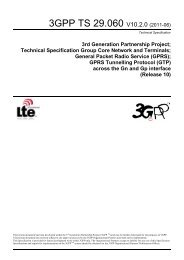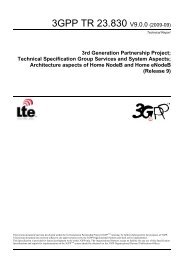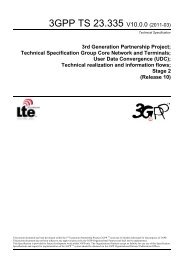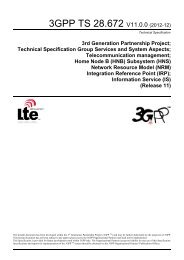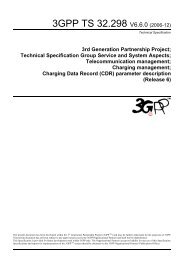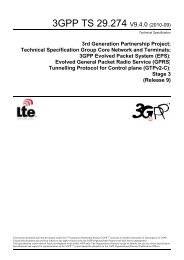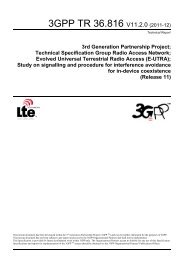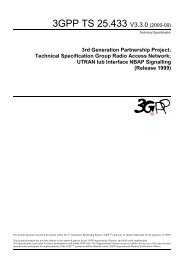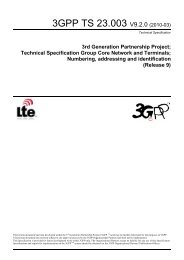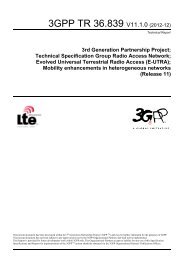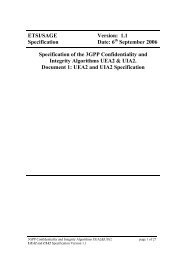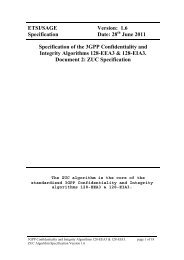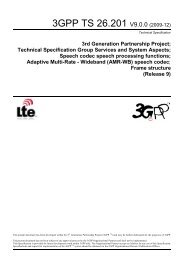Create successful ePaper yourself
Turn your PDF publications into a flip-book with our unique Google optimized e-Paper software.
<strong>3GPP</strong> <strong>TS</strong> <strong>29.173</strong> <strong>V10.0.0</strong> (<strong>2011</strong>-<strong>03</strong>)<br />
Technical Specification<br />
3rd Generation Partnership Project;<br />
Technical Specification Group Core Network and Terminals;<br />
Location Services (LCS);<br />
Diameter-based SLh interface for Control Plane LCS<br />
(Release 10)<br />
The present document has been developed within the 3 rd Generation Partnership Project (<strong>3GPP</strong> TM ) and may be further elaborated for the purposes of <strong>3GPP</strong>..<br />
The present document has not been subject to any approval process by the <strong>3GPP</strong> Organizational Partners and shall not be implemented.<br />
This Specification is provided for future development work within <strong>3GPP</strong> only. The Organizational Partners accept no liability for any use of this Specification.<br />
Specifications and reports for implementation of the <strong>3GPP</strong> TM system should be obtained via the <strong>3GPP</strong> Organizational Partners' Publications Offices.
Release 10<br />
2<br />
<strong>3GPP</strong> <strong>TS</strong> <strong>29.173</strong> <strong>V10.0.0</strong> (<strong>2011</strong>-<strong>03</strong>)<br />
Keywords<br />
LTE, LCS, SLh interface, Diameter<br />
<strong>3GPP</strong><br />
Postal address<br />
<strong>3GPP</strong> support office address<br />
650 Route des Lucioles - Sophia Antipolis<br />
Valbonne - FRANCE<br />
Tel.: +33 4 92 94 42 00 Fax: +33 4 93 65 47 16<br />
Internet<br />
http://www.3gpp.org<br />
Copyright Notification<br />
No part may be reproduced except as authorized by written permission.<br />
The copyright and the foregoing restriction extend to reproduction in all media.<br />
© <strong>2011</strong>, <strong>3GPP</strong> Organizational Partners (ARIB, ATIS, CCSA, E<strong>TS</strong>I, TTA, TTC).<br />
All rights reserved.<br />
UM<strong>TS</strong> is a Trade Mark of E<strong>TS</strong>I registered for the benefit of its members<br />
<strong>3GPP</strong> is a Trade Mark of E<strong>TS</strong>I registered for the benefit of its Members and of the <strong>3GPP</strong> Organizational Partners<br />
LTE is a Trade Mark of E<strong>TS</strong>I currently being registered for the benefit of its Members and of the <strong>3GPP</strong> Organizational Partners<br />
GSM® and the GSM logo are registered and owned by the GSM Association<br />
<strong>3GPP</strong>
Release 10<br />
3<br />
<strong>3GPP</strong> <strong>TS</strong> <strong>29.173</strong> <strong>V10.0.0</strong> (<strong>2011</strong>-<strong>03</strong>)<br />
Contents<br />
Foreword ...................................................................................................................................................... 5<br />
1 Scope .................................................................................................................................................. 6<br />
2 References .......................................................................................................................................... 6<br />
3 Definitions, symbols and abbreviations ............................................................................................... 7<br />
3.1 Definitions ................................................................................................................................................... 7<br />
3.2 Abbreviations............................................................................................................................................... 7<br />
4 General Description ............................................................................................................................ 7<br />
4.1 Introduction ................................................................................................................................................. 7<br />
4.2 Architecture Overview ................................................................................................................................. 7<br />
4.3 Functional Requirements of SLh Interface .................................................................................................... 8<br />
5 Diameter-based SLh Interface ............................................................................................................. 8<br />
5.1 Introduction ................................................................................................................................................. 8<br />
5.2 Procedure Descriptions................................................................................................................................. 8<br />
5.2.1 Send Routing Information for LCS .......................................................................................................... 8<br />
5.2.1.1 General ............................................................................................................................................. 8<br />
5.2.1.2 Detailed Behaviour of the HSS .......................................................................................................... 9<br />
5.2.1.3 Detailed Behaviour of the GLMC .................................................................................................... 10<br />
6 Protocol Specification and Implementations ...................................................................................... 10<br />
6.1 Introduction ............................................................................................................................................... 10<br />
6.1.1 Use of Diameter Base Protocol.............................................................................................................. 10<br />
6.1.2 Securing Diameter Messages ................................................................................................................ 10<br />
6.1.3 Accounting Functionality ...................................................................................................................... 10<br />
6.1.4 Use of Sessions ..................................................................................................................................... 10<br />
6.1.5 Transport Protocol ................................................................................................................................ 11<br />
6.1.6 Routing Considerations ......................................................................................................................... 11<br />
6.1.7 Advertising Application Support ........................................................................................................... 11<br />
6.1.8 Diameter Application Identifier ............................................................................................................. 11<br />
6.1.9 User Identity to HSS resolution ............................................................................................................. 11<br />
6.2 Commands ................................................................................................................................................. 12<br />
6.2.1 Introduction .......................................................................................................................................... 12<br />
6.2.2 Command-Code values ......................................................................................................................... 12<br />
6.2.3 LCS-Routing-Info-Request (RIR) Command ......................................................................................... 12<br />
6.2.4 LCS-Routing-Info-Answer (RIA) Command ......................................................................................... 13<br />
6.3 Result-Code AVP and Experimental-Result AVP Values ............................................................................ 13<br />
6.3.1 General ................................................................................................................................................. 13<br />
6.3.2 Success ................................................................................................................................................. 13<br />
6.3.3 Permanent Failures ............................................................................................................................... 13<br />
6.3.3.1 DIAMETER_ERROR_USER_UNKNOWN (5001) ......................................................................... 14<br />
6.3.3.2 DIAMETER_ERROR_UNAUTHORIZED_REQUESTING_NETWORK (5490) ............................ 14<br />
6.3.4 Transient Failures ................................................................................................................................ 14<br />
6.3.4.1 DIAMETER_ERROR_ABSENT_USER (4201) .............................................................................. 14<br />
6.4 AVPs ......................................................................................................................................................... 14<br />
6.4.1 General ................................................................................................................................................. 14<br />
6.4.2 LMSI.................................................................................................................................................... 15<br />
6.4.3 Serving-Node ....................................................................................................................................... 15<br />
6.4.4 MME-Name ......................................................................................................................................... 15<br />
6.4.5 MSC-Number ....................................................................................................................................... 15<br />
6.4.6 LCS-Capabilities-Sets ........................................................................................................................... 15<br />
6.4.7 GMLC-Address .................................................................................................................................... 16<br />
6.4.8 Additional-Serving-Node ...................................................................................................................... 16<br />
6.4.9 PPR-Address ........................................................................................................................................ 16<br />
6.4.10 Feature-List-ID AVP ............................................................................................................................ 16<br />
6.4.11 Feature-List AVP .................................................................................................................................. 16<br />
<strong>3GPP</strong>
Release 10<br />
4<br />
<strong>3GPP</strong> <strong>TS</strong> <strong>29.173</strong> <strong>V10.0.0</strong> (<strong>2011</strong>-<strong>03</strong>)<br />
Annex A (informative): Change history ........................................................................................... 17<br />
<strong>3GPP</strong>
Release 10<br />
5<br />
<strong>3GPP</strong> <strong>TS</strong> <strong>29.173</strong> <strong>V10.0.0</strong> (<strong>2011</strong>-<strong>03</strong>)<br />
Foreword<br />
This Technical Specification has been produced by the 3 rd Generation Partnership Project (<strong>3GPP</strong>).<br />
The contents of the present document are subject to continuing work within the <strong>TS</strong>G and may change following formal<br />
<strong>TS</strong>G approval. Should the <strong>TS</strong>G modify the contents of the present document, it will be re-released by the <strong>TS</strong>G with an<br />
identifying change of release date and an increase in version number as follows:<br />
Version x.y.z<br />
where:<br />
x the first digit:<br />
1 presented to <strong>TS</strong>G for information;<br />
2 presented to <strong>TS</strong>G for approval;<br />
3 or greater indicates <strong>TS</strong>G approved document under change control.<br />
y the second digit is incremented for all changes of substance, i.e. technical enhancements, corrections, updates,<br />
etc.<br />
z the third digit is incremented when editorial only changes have been incorporated in the document.<br />
<strong>3GPP</strong>
Release 10<br />
6<br />
<strong>3GPP</strong> <strong>TS</strong> <strong>29.173</strong> <strong>V10.0.0</strong> (<strong>2011</strong>-<strong>03</strong>)<br />
1 Scope<br />
The present document describes the Diameter-based SLh interface between the GMLC and the HSS defined for the<br />
Control Plane LCS in EPC.<br />
LCS procedures over the SLh interface are defined in the <strong>3GPP</strong> <strong>TS</strong> 23.271 [2].<br />
This specification defines the Diameter application for the GMLC-HSS, SLh reference point. The interactions between<br />
the HSS and the GMLC are specified, including the signalling flows. As LCS procedures over the Diameter-based SLh<br />
interface are identical to the MAP-based Lh interface, the descriptions of the Lh MAP operations defined in the <strong>3GPP</strong><br />
<strong>TS</strong> 29.002 [3] are mapped into the descriptions of the SLh Diameter commands.<br />
2 References<br />
The following documents contain provisions which, through reference in this text, constitute provisions of the present<br />
document.<br />
- References are either specific (identified by date of publication, edition number, version number, etc.) or<br />
non-specific.<br />
- For a specific reference, subsequent revisions do not apply.<br />
- For a non-specific reference, the latest version applies. In the case of a reference to a <strong>3GPP</strong> document (including<br />
a GSM document), a non-specific reference implicitly refers to the latest version of that document in the same<br />
Release as the present document.<br />
[1] <strong>3GPP</strong> TR 21.905: "Vocabulary for <strong>3GPP</strong> Specifications".<br />
[2] <strong>3GPP</strong> <strong>TS</strong> 23.271: "Functional stage 2 description of Location Services (LCS)".<br />
[3] <strong>3GPP</strong> <strong>TS</strong> 29.002: "Mobile Application Part (MAP) specification".<br />
[4] <strong>3GPP</strong> <strong>TS</strong> 29.228: "IP multimedia (IM) Subsystem Cx Interface; Signalling flows and Message<br />
Elements".<br />
[5] IETF RFC 3588: "Diameter Base Protocol".<br />
[6] <strong>3GPP</strong> <strong>TS</strong> 33.210: "3G security; Network Domain Security (NDS); IP network layer security".<br />
[7] IETF RFC 4960: "Stream Control Transport Protocol".<br />
[8] <strong>3GPP</strong> <strong>TS</strong> 29.229: "Cx and Dx Interfaces based on the Diameter protocol; protocol details".<br />
[9] <strong>3GPP</strong> <strong>TS</strong> 29.329: "Sh Interface based on the Diameter protocol; protocol details".<br />
[10] <strong>3GPP</strong> <strong>TS</strong> 23.0<strong>03</strong>: "Numbering, addressing and identification ".<br />
[11] <strong>3GPP</strong> <strong>TS</strong> 23.012: "Location Management Procedures".<br />
[12] <strong>3GPP</strong> <strong>TS</strong> 29.272: "Mobility Management Entity (MME) and Serving GPRS Support Node<br />
(SGSN) related interfaces based on Diameter protocol".<br />
[13] IETF RFC 2234: "Augmented BNF for syntax specifications".<br />
[14] <strong>3GPP</strong> <strong>TS</strong> 29.234: "<strong>3GPP</strong> system to Wireless Local Area Network (WLAN) Interworking; Stage 3".<br />
<strong>3GPP</strong>
Release 10<br />
7<br />
<strong>3GPP</strong> <strong>TS</strong> <strong>29.173</strong> <strong>V10.0.0</strong> (<strong>2011</strong>-<strong>03</strong>)<br />
3 Definitions, symbols and abbreviations<br />
3.1 Definitions<br />
For the purposes of the present document, the terms and definitions given in <strong>3GPP</strong> TR 21.905 [1], <strong>3GPP</strong> <strong>TS</strong> 23.271 [2]<br />
and the following apply. A term defined in the present document takes precedence over the definition of the same term,<br />
if any, in TR 21.905 [1].<br />
3.2 Abbreviations<br />
For the purposes of the present document, the abbreviations given in <strong>3GPP</strong> TR 21.905 [1] and the following apply. An<br />
abbreviation defined in the present document takes precedence over the definition of the same abbreviation, if any, in<br />
<strong>3GPP</strong> TR 21.905 [1].<br />
ABNF<br />
AVP<br />
H-GMLC<br />
IANA<br />
PMD<br />
PPR<br />
R-GMLC<br />
RFC<br />
V-GMLC<br />
Augmented Backus-Naur form<br />
Attribute Value Pair<br />
Home-Gateway Mobile Location Centre<br />
Internet Assigned Numbers Authority<br />
Pseudonym mediation device functionality<br />
Privacy Profile Register<br />
Requesting-Gateway Mobile Location Centre<br />
Request For Comments<br />
Visited-Gateway Mobile Location Centre<br />
4 General Description<br />
4.1 Introduction<br />
The SLh reference point between the GMLC and the HSS is defined in the <strong>3GPP</strong> <strong>TS</strong> 23.271 [2].<br />
This document describes the Diameter-based SLh interface related procedures, message parameters and protocol<br />
specifications.<br />
4.2 Architecture Overview<br />
The architecture for support of Location Services in GSM, UM<strong>TS</strong> and EPS has been defined in <strong>3GPP</strong> <strong>TS</strong> 23.271 [2]<br />
and the relevant network elements and interfaces are shown in the figure 4.2-1.<br />
<strong>3GPP</strong>
Release 10<br />
8<br />
<strong>3GPP</strong> <strong>TS</strong> <strong>29.173</strong> <strong>V10.0.0</strong> (<strong>2011</strong>-<strong>03</strong>)<br />
Figure 4.2-1: Overview of the LCS Functional Architecture<br />
In this architecture, the SLh interface is defined between the Gateway Mobile Location Center (GMLC) and the Home<br />
Subscriber Server (HSS) to allow the GMLC to request routing information from the HLR or HSS.<br />
4.3 Functional Requirements of SLh Interface<br />
The requirements for SLh interface are defined in <strong>3GPP</strong> <strong>TS</strong> 23.271 [2].<br />
The SLh interface is used by the GMLC to request routing information from the HSS i.e. the address of the H-GMLC,<br />
and/or the address of the visited MSC/MSC server, SGSN, <strong>3GPP</strong> AAA server or MME for a particular target UE whose<br />
location has been requested.<br />
5 Diameter-based SLh Interface<br />
5.1 Introduction<br />
This section describes the Diameter-based SLh interface related procedures and Information elements exchanged<br />
between functional entities.<br />
In the tables that describe the Information Elements transported by each Diameter command, each Information Element<br />
is marked as (M) Mandatory, (C) Conditional or (O) Optional in the "Cat." column. For the correct handling of the<br />
Information Element according to the category type, see the description detailed in section 6 of the <strong>3GPP</strong> <strong>TS</strong> 29.228 [4].<br />
5.2 Procedure Descriptions<br />
5.2.1 Send Routing Information for LCS<br />
5.2.1.1 General<br />
This procedure is used between the GMLC and the HSS. The procedure is invoked by the GMLC and is used:<br />
- To retrieve routing information for LCS for a specified user from the HSS.<br />
<strong>3GPP</strong>
Release 10<br />
9<br />
<strong>3GPP</strong> <strong>TS</strong> <strong>29.173</strong> <strong>V10.0.0</strong> (<strong>2011</strong>-<strong>03</strong>)<br />
This procedure is mapped to the commands LCS-Routing-Info-Request/Answer in the Diameter application specified in<br />
chapter 6. Tables 5.2.1.1/1 and 5.2.1.1/2 detail the involved information elements.<br />
Table 5.2.1.1/1: Send Routing Information for LCS (SLh-LCS-SRI)<br />
Information<br />
element name<br />
Mapping to<br />
Diameter AVP<br />
Cat.<br />
Description<br />
IMSI User-Name C This information element shall contain the IMSI of the targeted<br />
user. This IE shall be present if the MSISDN is absent.<br />
MSISDN MSISDN C This information element shall contain the MSISDN of the<br />
targeted user. This IE shall be present if the IMSI is absent.<br />
GMLC Number GMLC-Number O This information element shall contain the ISDN (E.164) number<br />
of the requesting GMLC.<br />
Supported Features<br />
(See <strong>3GPP</strong> <strong>TS</strong><br />
29.229 [8])<br />
Supported-Features O If present, this information element shall contain the list of<br />
features supported by the origin host.<br />
Table 5.2.1.1/2: Send Routing Information for LCS (SLh-LCS-SRI) Resp<br />
Information<br />
element<br />
name<br />
Mapping to<br />
Diameter AVP<br />
Cat.<br />
Description<br />
Result<br />
(See 5.3.5)<br />
Result-Code /<br />
Experimental-<br />
Result<br />
M<br />
Result of the request.<br />
Result-Code AVP shall be used for errors defined in the Diameter Base<br />
Protocol.<br />
Experimental-Result AVP shall be used for SLh errors. This is a grouped<br />
AVP which contains the <strong>3GPP</strong> Vendor ID in the Vendor-Id AVP, and the<br />
error code in the Experimental-Result-Code AVP.<br />
IMSI User-Name C This information element shall contain the IMSI of the targeted user. This<br />
IE shall be present if the MSISDN is absent.<br />
MSISDN MSISDN C This information element shall contain the MSISDN of the targeted user.<br />
This IE shall be present if the IMSI is absent.<br />
LMSI LMSI C This information element shall contain the LMSI allocated by the VLR. If<br />
available in the HSS, this IE shall be present only when the Result- Code is<br />
DIAMETER_SUCCESS and the serving node is a VLR.<br />
Serving Node Serving-Node C This information element shall contain the information about the network<br />
node serving the targeted user i.e. the name/number of the serving node<br />
(MME, SGSN, <strong>3GPP</strong> AAA server or MSC/MSC server), the LCS<br />
capabilities sets supported by the serving node and the IP address of the<br />
visited GMLC associated with the serving node. This IE shall be present<br />
only when the Result- Code is DIAMETER_SUCCESS.<br />
Additional<br />
Serving Node<br />
Additional-<br />
Serving-Node<br />
C<br />
This information element shall contain the information about another<br />
network node serving the targeted user. This IE shall be present only when<br />
the Result- Code is DIAMETER_SUCCESS. There may be multiple<br />
instances of this IE in the response provided by the HSS.<br />
Home GMLC<br />
Address<br />
GMLC-Address C This information element shall contain the IP address of the H-GMLC. This<br />
IE shall be present only when the Result-Code is DIAMETER_SUCCESS.<br />
PPR Address PPR-Address C This information element shall contain the IP address of the Privacy Profile<br />
Register (PPR). If available in the HSS, this IE shall be present only when<br />
the Result-Code is DIAMETER_SUCCESS.<br />
Supported<br />
Features<br />
(See <strong>3GPP</strong> <strong>TS</strong><br />
29.229 [8])<br />
Supported-<br />
Features<br />
O<br />
If present, this information element shall contain the list of features<br />
supported by the origin host.<br />
5.2.1.2 Detailed Behaviour of the HSS<br />
Upon reception of the Send Routing Info for LCS request, the HSS shall, in the following order:<br />
<strong>3GPP</strong>
Release 10<br />
10<br />
<strong>3GPP</strong> <strong>TS</strong> <strong>29.173</strong> <strong>V10.0.0</strong> (<strong>2011</strong>-<strong>03</strong>)<br />
1. Check whether the requesting GMLC belongs to a network authorized to request UE location information. If not,<br />
Experimental-Result shall be set to DIAMETER_ERROR_UNAUTHORIZED_REQUESTING_NETWORK in<br />
the Send Routing Information for LCS Response.<br />
2. Check that the User Identity for whom data is asked exists in HSS. If not, Experimental-Result shall be set to<br />
DIAMETER_ERROR_USER_UNKNOWN in the Send Routing Information for LCS Response.<br />
3. Check that there is serving node associated with the targeted user. If not, Experimental-Result shall be set to<br />
DIAMETER_ERROR_ABSENT_USER in the Send Routing Information for LCS Response.<br />
If there is an error in any of the above steps then the HSS shall stop processing and shall return the error code specified<br />
in the respective step (see <strong>3GPP</strong> <strong>TS</strong> 29.329 [9] and <strong>3GPP</strong> <strong>TS</strong> 29.229 [8] for an explanation of the error codes).<br />
If the HSS cannot fulfil the received request for reasons not stated in the above steps, e.g. due to a database error or<br />
empty mandatory data elements, it shall stop processing the request and set Result-Code to<br />
DIAMETER_UNABLE_TO_COMPLY.<br />
Otherwise, the requested operation shall take place and the HSS shall return the Result-Code AVP set to<br />
DIAMETER_SUCCESS. The HSS returns one or several of the network addresses of the current MME, SGSN,<br />
<strong>3GPP</strong> AAA server and/or VMSC/MSC server, the LCS capabilities of the serving nodes if available, the V-GMLC<br />
address associated with the serving nodes, if available, and whichever of the IMSI and MSISDN that was not provided<br />
in the Send Routing Info for LCS request. The HSS returns the address of the H-GMLC. The HSS also provides the<br />
address of the PPR, if available.<br />
5.2.1.3 Detailed Behaviour of the GLMC<br />
If there are a serving node as well as additional serving nodes in a successful Send Routing Info for LCS response, the<br />
receiving shall use the serving node in preference to the additional serving nodes.<br />
6 Protocol Specification and Implementations<br />
6.1 Introduction<br />
6.1.1 Use of Diameter Base Protocol<br />
The Diameter Base Protocol as specified in IETF RFC 3588 [5] shall apply except as modified by the defined support<br />
of the methods and the defined support of the commands and AVPs, result and error codes as specified in this<br />
specification. Unless otherwise specified, the procedures (including error handling and unrecognised information<br />
handling) shall be used unmodified.<br />
6.1.2 Securing Diameter Messages<br />
For secure transport of Diameter messages, see <strong>3GPP</strong> <strong>TS</strong> 33.210 [6].<br />
6.1.3 Accounting Functionality<br />
Accounting functionality (Accounting Session State Machine, related command codes and AVPs) shall not be used on<br />
the SLh interface.<br />
6.1.4 Use of Sessions<br />
Between the GMLC and the HSS, Diameter sessions shall be implicitly terminated. An implicitly terminated session is<br />
one for which the server does not maintain state information. The client shall not send any re-authorization or session<br />
termination requests to the server.<br />
The Diameter base protocol includes the Auth-Session-State AVP as the mechanism for the implementation of<br />
implicitly terminated sessions.<br />
<strong>3GPP</strong>
Release 10<br />
11<br />
<strong>3GPP</strong> <strong>TS</strong> <strong>29.173</strong> <strong>V10.0.0</strong> (<strong>2011</strong>-<strong>03</strong>)<br />
The client (server) shall include in its requests (responses) the Auth-Session-State AVP set to the value<br />
NO_STATE_MAINTAINED (1), as described in IETF RFC 3588 [5]. As a consequence, the server shall not maintain<br />
any state information about this session and the client shall not send any session termination request. Neither the<br />
Authorization-Lifetime AVP nor the Session-Timeout AVP shall be present in requests or responses.<br />
6.1.5 Transport Protocol<br />
Diameter messages over the SLh interface shall make use of SCTP IETF RFC 4960 [7] as transport protocol.<br />
6.1.6 Routing Considerations<br />
This clause specifies the use of the Diameter routing AVPs Destination-Realm and Destination-Host.<br />
If GMLC knows the address/name of the HSS for a certain user, both the Destination-Realm AVP and the Destination-<br />
Host AVP shall be present in the request. Otherwise, only the Destination-Realm AVP shall be present and the<br />
command shall be routed to the next Diameter node. Consequently, the Destination-Host AVP is declared as optional in<br />
the ABNF for all requests initiated by a GMLC.<br />
Destination-Realm AVP is declared as mandatory in the ABNF for all requests.<br />
6.1.7 Advertising Application Support<br />
The HSS and GMLC shall advertise support of the Diameter SLh Application by including the value of the application<br />
identifier in the Auth-Application-Id AVP within the Vendor-Specific-Application-Id grouped AVP of the Capabilities-<br />
Exchange-Request and Capabilities-Exchange-Answer commands.<br />
The vendor identifier value of <strong>3GPP</strong> (10415) shall be included in the Supported-Vendor-Id AVP of the Capabilities-<br />
Exchange-Request and Capabilities-Exchange-Answer commands, and in the Vendor-Id AVP within the Vendor-<br />
Specific-Application-Id grouped AVP of the Capabilities-Exchange-Request and Capabilities-Exchange-Answer<br />
commands.<br />
The Vendor-Id AVP included in Capabilities-Exchange-Request and Capabilities-Exchange-Answer commands that is<br />
not included in the Vendor-Specific-Application-Id AVPs as described above shall indicate the manufacturer of the<br />
Diameter node as per RFC 3588 [5].<br />
6.1.8 Diameter Application Identifier<br />
The SLh interface protocol shall be defined as an IETF vendor specific Diameter application, where the vendor is <strong>3GPP</strong>.<br />
The vendor identifier assigned by IANA to <strong>3GPP</strong> (http://www.iana.org/assignments/enterprise-numbers) is 10415.<br />
The Diameter application identifier assigned to the SLh interface application is 16777291 (allocated by IANA).<br />
6.1.9 User Identity to HSS resolution<br />
The User identity to HSS resolution mechanism enables the GMLC (for non-roaming case) or Diameter Relay/proxy<br />
agents in the home network (for roaming case) to find the identity of the HSS that holds the LCS subscription data and<br />
routing information for the target user when multiple and separately addressable HSSs have been deployed in the home<br />
network. The resolution mechanism is not required in networks that utilise a single HSS.<br />
This User identity to HSS resolution mechanism may rely on routing capabilities provided by Diameter and be<br />
implemented in the home operator network within dedicated Diameter Agents (Redirect Agents or Proxy Agents)<br />
responsible for determining the HSS identity based on the provided user identity. If this Diameter based implementation<br />
is selected by the Home network operator, the principles described in the <strong>3GPP</strong> <strong>TS</strong> 29.272 [12] shall apply.<br />
NOTE:<br />
Alternatives to the user identity to HSS resolution Diameter based implementation are outside the scope<br />
of this specification.<br />
<strong>3GPP</strong>
Release 10<br />
12<br />
<strong>3GPP</strong> <strong>TS</strong> <strong>29.173</strong> <strong>V10.0.0</strong> (<strong>2011</strong>-<strong>03</strong>)<br />
6.2 Commands<br />
6.2.1 Introduction<br />
This section defines the Command code values and related ABNF for each command described in this specification.<br />
6.2.2 Command-Code values<br />
This section defines Command-Code values for the SLh interface application as allocated by IANA.<br />
Every command is defined by means of the ABNF syntax IETF RFC 2234 [13], according to the rules in IETF RFC<br />
3588 [5]. In the case, the definition and use of an AVP is not specified in this document, the guidelines in IETF RFC<br />
3588 [5] shall apply.<br />
The following Command Codes are defined in this specification:<br />
Table 6.2.2/1: Command-Code values for SLh<br />
Command-Name<br />
Abbreviatio<br />
n<br />
Code<br />
Section<br />
LCS-Routing-Info-Request RIR 8388622 6.2.3<br />
LCS-Routing-Info-Answer RIA 8388622 6.2.4<br />
For these commands, the Application-ID field shall be set to 16777291 (application identifier of the SLh interface<br />
application, allocated by IANA).<br />
6.2.3 LCS-Routing-Info-Request (RIR) Command<br />
The LCS-Routing-Info-Request (RIR) command, indicated by the Command-Code field set to 8388622 and the "R" bit<br />
set in the Command Flags field, is sent from GMLC to HSS.<br />
Message Format<br />
< LCS-Routing-Info-Request> ::= < Diameter Header: 8388622, REQ, PXY, 16777291 ><br />
< Session-Id ><br />
{ Auth-Session-State }<br />
{ Origin-Host }<br />
{ Origin-Realm }<br />
[ Destination-Host ]<br />
{ Destination-Realm }<br />
[ User-Name ]<br />
[ MSISDN ]<br />
[ GMLC-Number ]<br />
*[ Supported-Features ]<br />
*[ Proxy-Info ]<br />
*[ Route-Record ]<br />
*[ AVP ]<br />
<strong>3GPP</strong>
Release 10<br />
13<br />
<strong>3GPP</strong> <strong>TS</strong> <strong>29.173</strong> <strong>V10.0.0</strong> (<strong>2011</strong>-<strong>03</strong>)<br />
6.2.4 LCS-Routing-Info-Answer (RIA) Command<br />
The LCS-Routing-Info-Answer (RIA) command, indicated by the Command-Code field set to 8388622 and the 'R' bit<br />
cleared in the Command Flags field, is sent from HSS to GMLC.<br />
Message Format<br />
< LCS-Routing-Info-Answer> ::= < Diameter Header: 8388622, PXY, 16777291 ><br />
< Session-Id ><br />
[ Result-Code ]<br />
[ Experimental-Result ]<br />
{ Auth-Session-State }<br />
{ Origin-Host }<br />
{ Origin-Realm }<br />
*[ Supported-Features ]<br />
[ User-Name ]<br />
[ MSISDN ]<br />
[ LMSI ]<br />
[ Serving-Node ]<br />
*[ Additional-Serving-Node ]<br />
[ GMLC-Address ]<br />
[ PPR-Address ]<br />
*[ AVP ]<br />
*[ Failed-AVP ]<br />
*[ Proxy-Info ]<br />
*[ Route-Record ]<br />
6.3 Result-Code AVP and Experimental-Result AVP Values<br />
6.3.1 General<br />
This section defines result code values that shall be supported by all Diameter implementations that conform to this<br />
specification.<br />
6.3.2 Success<br />
Result codes that fall within the Success category shall be used to inform a peer that a request has been successfully<br />
completed. The Result-Code AVP values defined in Diameter Base Protocol RFC 3588 [5] shall be applied.<br />
6.3.3 Permanent Failures<br />
Errors that fall within the Permanent Failures category shall be used to inform the peer that the request has failed, and<br />
should not be attempted again. The Result-Code AVP values defined in Diameter Base Protocol RFC 3588 [5] shall be<br />
applied. When one of the result codes defined here is included in a response, it shall be inside an Experimental-Result<br />
AVP and the Result-Code AVP shall be absent.<br />
<strong>3GPP</strong>
Release 10<br />
14<br />
<strong>3GPP</strong> <strong>TS</strong> <strong>29.173</strong> <strong>V10.0.0</strong> (<strong>2011</strong>-<strong>03</strong>)<br />
6.3.3.1 DIAMETER_ERROR_USER_UNKNOWN (5001)<br />
This result code shall be sent by the HSS to indicate that the user identified by the IMSI or the MSISDN is unknown.<br />
This error code is defined in <strong>3GPP</strong> <strong>TS</strong> 29.229 [8]<br />
6.3.3.2 DIAMETER_ERROR_UNAUTHORIZED_REQUESTING_NETWORK (5490)<br />
This result code shall be sent by the HSS to indicate that the requesting GMLC's network is not authorized to request<br />
UE location information.<br />
6.3.4 Transient Failures<br />
Errors that fall within the transient failures category are those used to inform a peer that the request could not be<br />
satisfied at the time that it was received. The request may be able to be satisfied in the future.<br />
6.3.4.1 DIAMETER_ERROR_ABSENT_USER (4201)<br />
This result code shall be sent by the HSS to indicate that the location of the targeted user is not known at this time to<br />
satisfy the requested operation.<br />
6.4 AVPs<br />
6.4.1 General<br />
The following table specifies the Diameter AVPs defined for the SLh interface protocol, their AVP Code values, types,<br />
possible flag values and whether or not the AVP may be encrypted. The Vendor-ID header of all AVPs defined in this<br />
specification shall be set to <strong>3GPP</strong> (10415).<br />
Table 6.4.1/1: SLh specific Diameter AVPs<br />
AVP Flag rules<br />
Attribute Name<br />
AVP<br />
Code<br />
Section<br />
defined<br />
Value Type Must May Should<br />
not<br />
Must<br />
not<br />
May<br />
Encr.<br />
LMSI 2400 6.4.2 OctetString M, V No<br />
Serving-Node 2401 6.4.3 Grouped M, V No<br />
MME-Name 2402 6.4.4 DiameterIdentity M, V No<br />
MSC-Number 24<strong>03</strong> 6.4.5 OctetString M, V No<br />
LCS-Capabilities- 2404 6.4.6 Unsigned32 M, V No<br />
Sets<br />
GMLC-Address 2405 6.4.7 Address M, V No<br />
Additional-Serving- 2406 6.4.8 Grouped M, V No<br />
Node<br />
PPR-Address 2407 6.4.9 Address M, V No<br />
NOTE 1: The AVP header bit denoted as "M", indicates whether support of the AVP is required. The AVP header bit<br />
denoted as "V", indicates whether the optional Vendor-ID field is present in the AVP header. For further<br />
details, see IETF RFC 3588 [5].<br />
The following table specifies the Diameter AVPs re-used by the SLh interface protocol from existing Diameter<br />
Applications, including a reference to their respective specifications and when needed, a short description of their use<br />
within SLh.<br />
Any other AVPs from existing Diameter Applications, except for the AVPs from Diameter Base Protocol, do not need<br />
to be supported. The AVPs from Diameter Base Protocol are not included in table 6.4.1/2, but they may be re-used for<br />
the SLh protocol.<br />
<strong>3GPP</strong>
Release 10<br />
15<br />
<strong>3GPP</strong> <strong>TS</strong> <strong>29.173</strong> <strong>V10.0.0</strong> (<strong>2011</strong>-<strong>03</strong>)<br />
Table 6.4.1/2: SLh re-used Diameter AVPs<br />
Attribute Name Reference Comments<br />
MSISDN <strong>3GPP</strong> <strong>TS</strong> 29.329 [9]<br />
SGSN-Number <strong>3GPP</strong> <strong>TS</strong> 29.272 [12]<br />
Supported-Features <strong>3GPP</strong> <strong>TS</strong> 29.229 [8]<br />
Feature-List-ID <strong>3GPP</strong> <strong>TS</strong> 29.229 [8] See section 6.4.10<br />
Feature-List <strong>3GPP</strong> <strong>TS</strong> 29.229 [8] See section 6.4.11<br />
GMLC-Number <strong>3GPP</strong> <strong>TS</strong> 29.272 [12]<br />
<strong>3GPP</strong>-AAA-Server-Name <strong>3GPP</strong> <strong>TS</strong> 29.234 [14]<br />
6.4.2 LMSI<br />
The LMSI AVP is of type OctetString and it shall contain the Local Mobile Station Identity (LMSI) allocated by the<br />
VLR, as defined in <strong>3GPP</strong> <strong>TS</strong> 23.0<strong>03</strong> [10]. For further details on the encoding of this AVP, see <strong>3GPP</strong> <strong>TS</strong> 23.0<strong>03</strong>[10].<br />
6.4.3 Serving-Node<br />
The Serving-Node AVP is of type Grouped. This AVP shall contain the information about the network node serving the<br />
targeted user.<br />
AVP format<br />
Serving-Node ::= <br />
[ SGSN-Number ]<br />
[ MME-Name ]<br />
[ MSC-Number ]<br />
[ <strong>3GPP</strong>-AAA-Server-Name ]<br />
[ LCS-Capabilities-Sets ]<br />
[ GMLC-Address ]<br />
*[AVP]<br />
The GMLC-Address AVP included in the Serving-Node grouped AVP shall contain, if present, the IPv4 or IPv6<br />
address of the GMLC associated with the serving node (i.e., either the home GMLC or the visited GMLC, depending on<br />
the location of the serving node).<br />
6.4.4 MME-Name<br />
The MME-Name AVP is of type DiameterIdentity and it shall contain the Diameter identity of the serving MME. For<br />
further details on the encoding of this AVP, see IETF RFC 3588 [5].<br />
6.4.5 MSC-Number<br />
The MSC-Number AVP is of type OctetString and it shall contain the ISDN number of the serving MSC or MSC server.<br />
For further details on the encoding of this AVP, see <strong>3GPP</strong> <strong>TS</strong> 23.0<strong>03</strong>[10].<br />
6.4.6 LCS-Capabilities-Sets<br />
The LCS-Capabilities-Sets AVP is of type Unsigned32 and it shall contain a bit mask. The meaning of the bits shall be<br />
as defined in <strong>3GPP</strong> 29.002 [3].<br />
<strong>3GPP</strong>
Release 10<br />
16<br />
<strong>3GPP</strong> <strong>TS</strong> <strong>29.173</strong> <strong>V10.0.0</strong> (<strong>2011</strong>-<strong>03</strong>)<br />
6.4.7 GMLC-Address<br />
The GMLC-Address AVP is of type Address and shall contain the IPv4 or IPv6 address of H-GMLC or the V-GMLC<br />
associated with the serving node.<br />
6.4.8 Additional-Serving-Node<br />
The Additional-Serving-Node AVP is of type Grouped. This AVP shall contain the information about the network node<br />
serving the targeted user.<br />
AVP format<br />
Additional-Serving-Node ::= <br />
[ SGSN-Number ]<br />
[ MME-Name ]<br />
[ MSC-Number ]<br />
[ <strong>3GPP</strong>-AAA-Server-Name ]<br />
[ LCS-Capabilities-Sets ]<br />
[ GMLC-Address ]<br />
*[AVP]<br />
The GMLC-Address AVP included in the Additional-Serving-Node grouped AVP shall contain, if present, the IPv4 or<br />
IPv6 address of the GMLC associated with the serving node (i.e., either the home GMLC or the visited GMLC,<br />
depending on the location of the serving node).<br />
6.4.9 PPR-Address<br />
The PPR-Address AVP is of type Address and contains the IPv4 or IPv6 address of the Privacy Profile Register for the<br />
targeted user.<br />
6.4.10 Feature-List-ID AVP<br />
The syntax of this AVP is defined in <strong>3GPP</strong> <strong>TS</strong> 29.229 [8]. For this release, the Feature-List-ID AVP value shall be set<br />
to 1.<br />
6.4.11 Feature-List AVP<br />
The syntax of this AVP is defined in <strong>3GPP</strong> <strong>TS</strong> 29.229 [8]. A null value indicates that there is no feature used by the<br />
application.<br />
NOTE:<br />
There is no feature defined for this release.<br />
<strong>3GPP</strong>
Release 10<br />
17<br />
<strong>3GPP</strong> <strong>TS</strong> <strong>29.173</strong> <strong>V10.0.0</strong> (<strong>2011</strong>-<strong>03</strong>)<br />
Annex A (informative):<br />
Change history<br />
Change history<br />
Date <strong>TS</strong>G # <strong>TS</strong>G Doc. CR Rev Subject/Comment Old New<br />
2010-<strong>03</strong> CT#47 CP-<br />
090815<br />
<strong>TS</strong> presented for approval in CT#47 2.0.0 9.0.0<br />
2010-09 CT#49 CP-<br />
100463<br />
0002 1 Application ID and Command code values 9.0.0 9.1.0<br />
<strong>2011</strong>-<strong>03</strong> - - - - Update to Rel-10 version (MCC) 9.1.0 10.0.<br />
0<br />
<strong>3GPP</strong>



